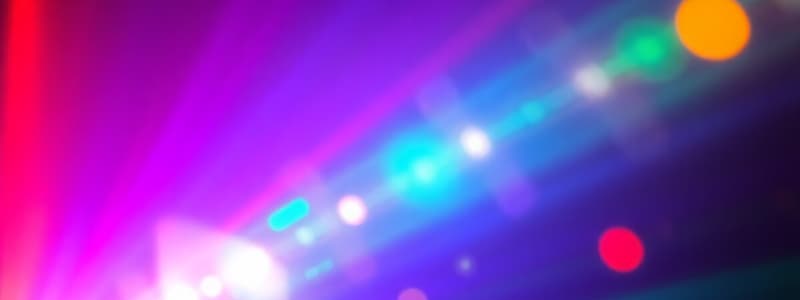Podcast
Questions and Answers
What type of light is produced in fluorescent lamps?
What type of light is produced in fluorescent lamps?
- Bioluminescence
- Fluorescence (correct)
- Incandescence
- Luminescence
Bioluminescence occurs without any chemical reactions within living organisms.
Bioluminescence occurs without any chemical reactions within living organisms.
False (B)
What common example produces light through electric discharge?
What common example produces light through electric discharge?
Neon lights
_____ is the type of light produced by chemical reactions, commonly seen in glow sticks.
_____ is the type of light produced by chemical reactions, commonly seen in glow sticks.
Match the following light production methods with their descriptions:
Match the following light production methods with their descriptions:
Flashcards
Incandescence
Incandescence
Light emitted by an object heated to a high temperature, causing it to glow. The heat excites the atoms within the object, making them release light.
Electric Discharge
Electric Discharge
Light produced when an electric current passes through a gas, exciting its atoms and causing them to emit light.
Luminescence
Luminescence
Light produced without significant heat, often through chemical or physical processes.
Fluorescence
Fluorescence
Signup and view all the flashcards
Bioluminescence
Bioluminescence
Signup and view all the flashcards
Study Notes
Light Source Descriptions
-
Sunlight/Nuclear Fusion: Light produced by nuclear fusion reactions in the Sun, where hydrogen atoms fuse to form helium, releasing energy. Examples include sunlight and solar radiation.
-
Incandescence: Light emitted when an object is heated to a high temperature, causing it to glow. Examples include light bulb filaments and molten metal.
-
Electric Discharge: Light created when an electric current passes through a gas, exciting its atoms and causing them to emit light. Examples include neon lights and lightning.
-
Luminescence: Light produced without significant heat, often through chemical or physical processes. Examples include glow sticks and LED lights.
-
Fluorescence: Light emitted when a substance absorbs high-energy UV light and re-emits visible light. Examples include fluorescent lamps and highlighters.
-
Phosphorescence: Light emission similar to fluorescence, but with delayed emission, continuing after the energy source is removed. Examples include glow-in-the-dark toys and watch dials.
-
Chemiluminescence: Light produced by a chemical reaction without a temperature increase. Examples include glow sticks and some chemical tests.
-
Bioluminescence: Light created by living organisms through chemical reactions within their bodies. Examples include fireflies and deep-sea organisms.
Studying That Suits You
Use AI to generate personalized quizzes and flashcards to suit your learning preferences.



